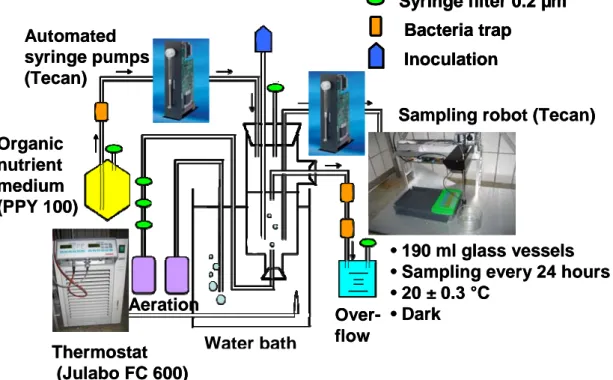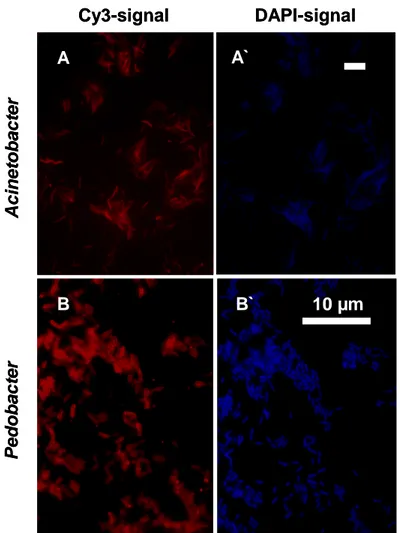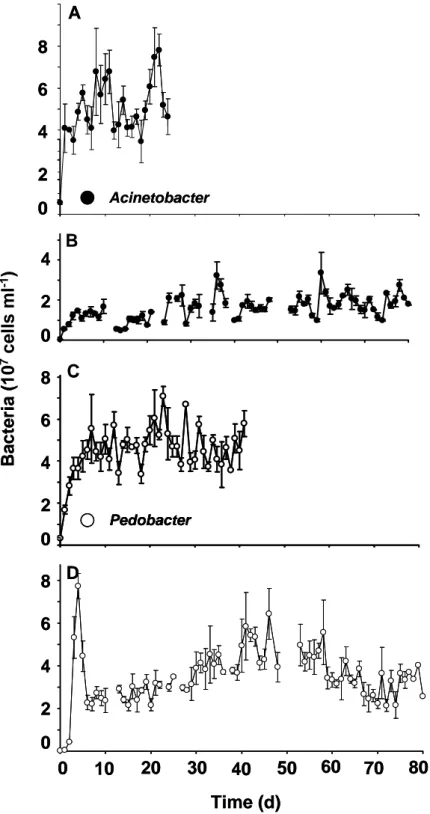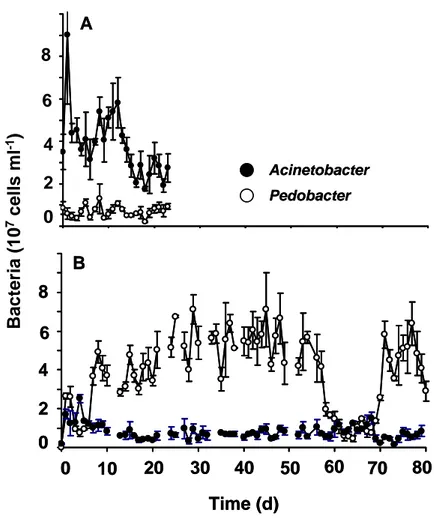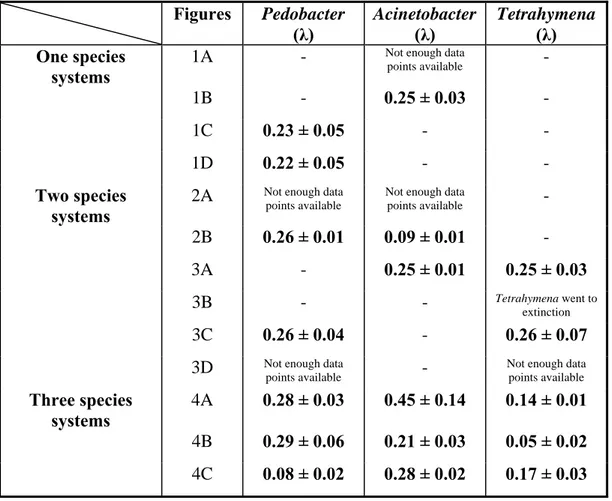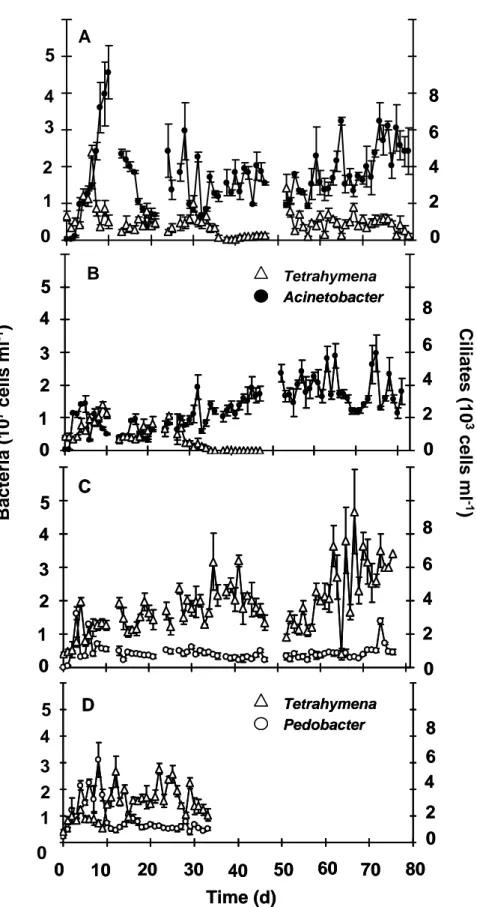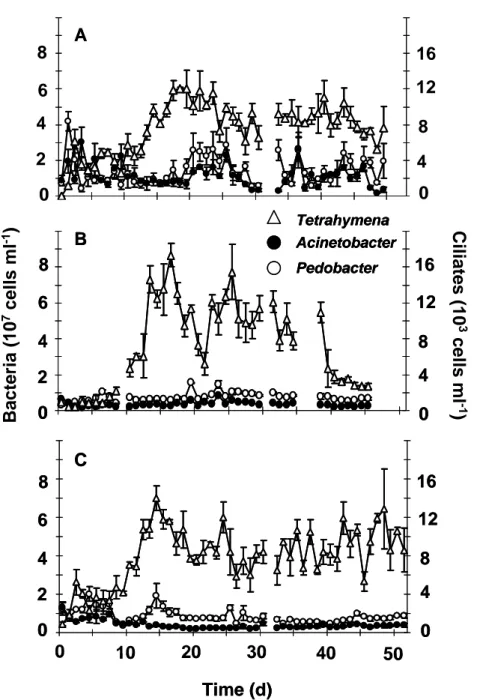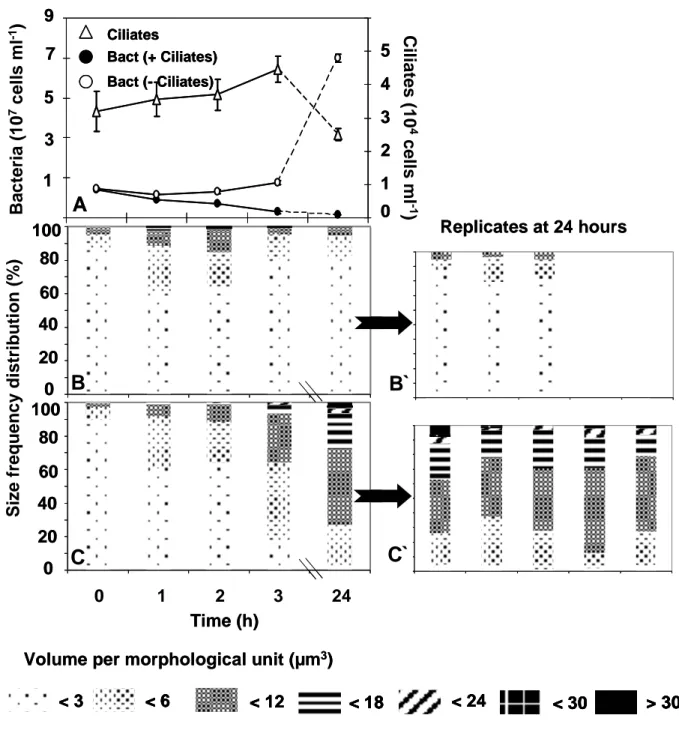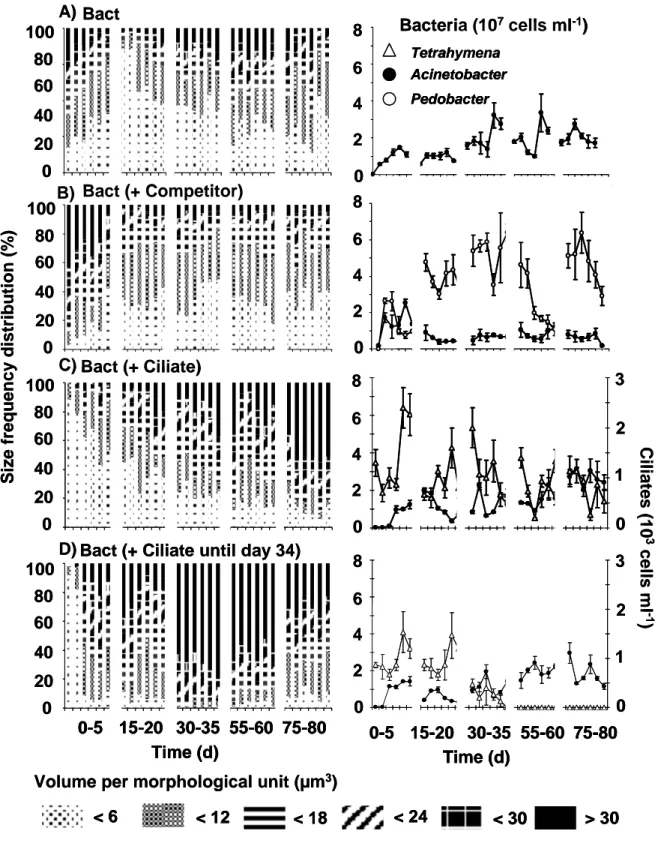The interplay of intrinsic and extrinsic parameters on the dynamic behaviour of a microbial food web
Inaugural-Dissertation zur
Erlangung des Doktorgrades
der Mathematisch-Naturwissenschaftlichen Fakultät der Universität zu Köln
vorgelegt von
Christine Willen aus Wildeshausen
Köln 2010
Berichterstatter: Prof. Dr. Hartmut Arndt Prof. Dr. Eric von Elert
Tag der mündlichen Prüfung: 18. November 2010
Danksagung
Bei Herrn Professor Doktor Hartmut Arndt bedanke ich mich herzlich für die Bereitstellung des Themas und für die Möglichkeit zur Promotion.
Innerhalb der Graduate School of Biological Sciences danke ich dem Thesis Committee bestehend aus: Professor Doktor Hartmut Arndt, Professor Doktor Eric von Elert und Professor Doktor Horst Malchow, für die kritischen Auseinandersetzungen zum Thema und für zusätzliche Anregungen hinsichtlich der experimentellen Untersuchungen.
Ich bedanke mich bei der gesamten AG Arndt für ihre Hilfe und Unterstützung.
Meinen direkten Arbeitskollegen Mar Monsonís Nomdedeu und Andre Schieffer danke ich für die fachliche Unterstützung und für die schöne Zeit zusammen in der Arbeitsgruppe.
Ich danke Nicole Nopper für Rechtschreibkorrekturen in der vorliegenden Arbeit.
Ein ganz besonderer Dank geht an meine Eltern und an meine Geschwister, da sie mir Rückhalt bieten.
Pages
Introduction 1 - 13
The interplay of intrinsic and extrinsic parameters on the dynamic behaviour of a microbial food web
Chapter I 14 - 29
Unbalanced variability at different trophic levels in an experimental microbial food web
Chapter II 30 - 46
Microevolution and inducible defence strategies of Acinetobacter johnsonii towards ciliate predation
Chapter III 47 - 61
The influence of temperature on the population dynamics of a microbial microcosm – model analyses and
chemostat experiments
Supplementary Material 62 - 68
Abstract 69 - 70
Kurzzusammenfassung 71 - 72
Introduction
The interplay of intrinsic and extrinsic parameters on the dynamic behaviour of a microbial food web
Background
Ecologists study the dynamic behaviour of organisms in order to understand their underlying driving forces (Turchin 2003). The interpretation of the observed time series data for their biological implications is a fundamental issue in ecology. Population dynamics are triggered by intrinsic and extrinsic parameters. Extrinsic parameter can be distinguished in biotic factors and abiotic factors. Abiotic factors include amongst others temperature, light and habitat structure. The most important biotic factors are for example competition for the present resources (nutrients and space) and predator-prey dynamics (Tollrian 1999; Persson et al. 2001). Population ecologists collect time series data in the field of single species or of key stone species within food webs in order to understand the underlying mechanisms of coexistence in the trophic cascades (Turchin 1995; Giovannoni & Stingl 2005; Corno et al. 2008; van der Stap et al. 2008).
However, for ecologists it is rather difficult to distinguish density depended and therefore purely intrinsic population dynamics from the influences of environmental factors (Kaitala et al. 1997; Upadhyay & Rai 1997;
Bjornstad & Grenfell 2001). Experiments in the field are faced with randomness which can alter population dynamics like unfavourable weather phenomena or unforeseen differences in the nutrient availability. Furthermore, they have to take in account short-term and long-term effects (for example daily temperature changes and seasonal temperature changes) on time series data (Hastings 2004; Rohani et al. 2004; Vasseur & Yodzis 2004). Therefore, it may be very difficult to understand the underlying mechanisms of population dynamics from field-data. One possibility to solve this problem are laboratory experiments.
Quasi-natural food web compositions serve as model-systems in which a selection of extrinsic parameters like temperature and predation can be studied separately (Cadotte et al. 2005).
Several model organisms have already been studied in the lab for example invertebrates, protists and bacteria (Costantino et al. 1997; Miramontes &
Rohani 1998; Hahn & Höfle 1999; Laakso et al. 2003; van der Stap et al. 2009).
Laboratory food webs consisting of bacteria and protists seem to be a useful tool to study in detail population dynamics because of short generation times and simple cultivation techniques (Jessup et al. 2004). Before one can apply any extrinsic parameter, one must study the intrinsic, density dependent population dynamics. Such laboratory experiments revealed different intrinsic population dynamics over time like stable equilibrium, predator-prey cycles or chaos (Fussmann et al. 2000; Beninca et al. 2008).
In natural habitats microbial food webs consisting of bacteria, algae and protozoans play an important role in the trophic cascade (e.g. within the microbial loop) of aquatic ecosystems like rivers and lakes (Azam et al. 1983;
Weisse et al. 1990; Weitere & Arndt 2003; Weitere et al. 2005). Protozoans for example heterotrophic flagellates and ciliates have a broad impact on the bacterial community structure (Beaver & Crisman 1989a; Boenigk & Arndt 2002;
Wey et al. 2008). Ciliates can constitute an important component of plankton in freshwater ecosystems depending on the lake trophic status (Simek et al.
1994). In mesothrophic and eutrophic lakes the ciliate abundance can range from 70 cells ml-1 up to 150 cells ml-1 (Beaver & Crisman 1989b). Bacterivory by pelagic ciliates is considered to be important in freshwater when bacterial abundances reach more than 5 x 106 ml-1 (Simek et al. 1994). Concerning microbial aquatic food webs protists are seen as a major source of mortality for both heterotrophic and autotrophic bacteria as they are ubiquitous and abundant in all types of habitats (Sherr & Sherr 2002). The protist Tetrahymena pyriformis is ubiquitous and abundant in several freshwater habitats and served as a model organism, grazing on two different bacterial strains in the present laboratory system.
The experimental setup
A simplified predator-prey system was designed not to mimic natural conditions but to examine in detail the impact of intrinsic and extrinsic parameters on the population dynamics over time. Therefore, my colleagues and me established a highly controllable and to the greatest possible extent automated experimental
setup for chemostat experiments (Fig. 1). External inaccuracies like fluctuations in the dilution rate (peristaltic pumps were replaced by more accurate syringe pumps (Supplementary Material Fig.1)), unintended temperature fluctuations and the risk of contaminations with other bacteria or fungi could be minimized due to an automated sampling robot. The first aim of the present work was to study purely intrinsic driven population dynamics at two trophic levels separately. The microbial model system consisted of three species, two different bacterial strains and a protist predator.
Thermostat (Julabo FC 600) Organic
nutrient medium (PPY 100)
Over- flow
•190 ml glass vessels
•Sampling every 24 hours
•20 ± 0.3 °C
•Dark Aeration
Automated syringe pumps (Tecan)
Sampling robot (Tecan) Syringe filter 0.2 µm
Bacteria trap Inoculation
Thermostat (Julabo FC 600) Organic
nutrient medium (PPY 100)
Over- flow
•190 ml glass vessels
•Sampling every 24 hours
•20 ± 0.3 °C
•Dark Aeration
Automated syringe pumps (Tecan)
Sampling robot (Tecan) Syringe filter 0.2 µm
Bacteria trap Inoculation
Syringe filter 0.2 µm Bacteria trap
Inoculation
Fig. 1. Schematic setup for chemostat experiments.
Water bath
In previous works (Becks et al. 2005) the two bacterial preys consisted of Brevundimonas sp. (alpha-proteobacteria, 1.5 x 1.5 µm, morphological stable) and Pedobacter sp. (cytophaga-flexibacter group, 1 x 2 µm, morphological stable, Fig. 2 B and B`). Grazing by Tetrahymena led to different predator-prey population dynamics like stable limit cycles, stable equilibrium and chaotic dynamics using the dilution rate as bifurcation parameter (the established dilution rates were 0.45, 0.5 and 0.75 per day). Coexistence of all three species (in a certain range of dilution rate per day between 0.1 and 0.9) was possible because Brevundimonas was the inferior competitor and the less preferred
prey. The observed dynamics at the different flow rates had been previously predicted by a simplified mathematical model (Takeuchi & Adachi 1983).
Chemostat experiments and model analyses
In the present work the less preferred bacterial prey, Brevundimonas sp. was replaced by Acinetobacter johnsonii (gamma-proteobacteria, Fig. 2 A and A`) to investigate a more realistic system including morphological changes of prey organisms in response to predation as it is common in the field (Hahn & Höfle 2001; Pernthaler 2005). We included Acinetobacter which is able to form different cell sizes with volumes ranging from 3 – 30 µm3 (single cells as well as chains of different lengths) without any external trigger in continuous culture as well as in over night grown batch cultures.
Cy3-signal DAPI-signal
AcinetobacterPedobacter
10 µm
A A`
B B`
Cy3-signal DAPI-signal
AcinetobacterPedobacter
10 µm
A A`
B B`
Fig. 2. Specifically labelled cells of Acinetobacter (A: Cy3-CARD-FISH-signal and A`
unspecific DAPI counterstain) and Pedobacter (B: Cy3-antibody-signal and B` unspecific DAPI counterstain) from over night grown stock cultures. Scale bars indicate 10 µm.
The second hypothesis of the present work was, if the morphology of Acinetobacter changes towards ciliate grazing. Single species and two-species predator-prey long-term chemostat experiments as well as short-term batch experiments were performed in order to study if there was a detectable shift towards larger, inedible growth forms. David Heckmann, a bachelor candidate of our working group, performed in 2009 corresponding model-analyses based on (Bohannan & Lenski 1999). He examined the influences of inducible defence mechanisms of one bacterial strain in a three species predator-prey model. His findings showed that predator triggered grazing resistance results in an increase of the range of dilution rates which allow coexistence of all three species (dilution rates of 0.1-1.3, Supplementary Material Fig. 2A) in comparison to a three species model without phenotypic plasticity with coexistence for a narrow range of dilution rates of 0.6-1.0, (Supplement Material Fig. 2B). Based on the model predictions of David Heckmann, chemostat experiments were performed in the present study in order to test the hypothesis, if the introduction of a morphological heterogeneous strain like Acinetobacter results in a higher range of coexistence in a three species microbial food web, concerning dilution rates in comparison to previous experiments performed by (Becks et al. 2005).
Temperature effects
Beside changes in the nutrient availability (dilution rate), predator-prey interactions are also triggered by temperature (Weisse et al. 2002; Gächter &
Weisse 2006; Viergutz et al. 2007). Temperature is one of the most important extrinsic factors influencing the overall intrinsic biological processes like metabolic growth, respiration, ingestion, reproduction (Laybourn & Finlay 1976;
Gillooly et al. 2001; Savage et al. 2004; Weitere et al. 2009). The influence of temperature gained more and more attention ever since the awareness of the global climate change (IPCC 2007). The response to global warming in ecosystems is a complex interplay of individuals and their temperature dependent reaction-norms. The study of temperature mediated changes in the trophic interaction modes revealed for example unexpected or harmful changes (Winder & Schindler 2004; Jiang & Morin 2007). Almost every kind of interaction ranging from the feeding behaviours, competitive relationships and predator
attacks react sensitively towards changing temperatures (McLaughlin et al.
2002; Norf et al. 2007; Viergutz et al. 2007). In the field, it is almost impossible to separate the impact of temperature from other internal or external triggers. In the background of climate change, it is of rising interest to which degree this extrinsic factor alters intrinsic population dynamics. Temperature fluctuations are very common in natural systems from daily temperature fluctuations on small scale changes to large scale changes due to e.g. seasonal shifts. This applies in particular to shallow aquatic environments like lakes, where stratification is normally absent and temperature refuges are minimal (McKee et al. 2002). Temperature may fluctuate in the littoral zone up to 10°C within one day (Montagnes & Weisse 2000), differences of up to 15°C may occur within one month. In the present study daily changing temperatures were fluctuating chaotically around 16.7 and 29.7°C in a course of 30 days. Chemostat experiments as well as corresponding model analyses should disentangle the impact of temperature fluctuations of the present three species microbial food web.
Summing up
In the present study the microbial food web consisted of three species (Fig. 3):
a bacterivorous ciliate Tetrahymena pyriformis and two bacterial organisms Acinetobacter johnsonii and Pedobacter sp. In the first Chapter, highly controllable chemostat experiments were performed in order to study purely intrinsic driven population dynamics of the microbial food web at constant external parameters. The dynamical behaviour in each trophic level from single species to three species predator-prey interactions were analysed in detail.
Beside the quantitative analyses, qualitative studies of the morphological heterogeneous strain Acinetobacter were carried out to test the hypothesis if grazing by Tetrahymena results in a shift of morphotypes towards larger growth forms (Chapter II). With this background and according to model predictions, the experimental microbial food web was analysed at two different external parameters in Chapter three. At first, the dilution rate was used as bifurcation parameter to test the hypothesis if the coexistence of all three species is enlarged when one bacterial strain exhibited phenotypic plasticity. Second,
chaotic temperature fluctuations were applied as an extrinsic trigger to study whether intrinsic population dynamics could be changed.
A) B) C)
Pedobacter Acinetobacter Tetrahymena
10 µm
A) B) C)
Pedobacter Acinetobacter Tetrahymena
10 µm
Fig. 3. Photographs of CYBR-Green stained cells of the three species microbial food web.
Scale bars indicate 10 µm in all pictures.
References
Azam F., Fenchel T., Field J.G., Gray J.S., Meyerreil L.A. & Thingstad F.
(1983). THE ECOLOGICAL ROLE OF WATER-COLUMN MICROBES IN THE SEA. Marine Ecology-Progress Series, 10, 257-263.
Beaver J.R. & Crisman T.L. (1989a). ANALYSIS OF THE COMMUNITY STRUCTURE OF PLANKTONIC CILIATED PROTOZOA RELATIVE TO TROPHIC STATE IN FLORIDA LAKES. Hydrobiologia, 174, 177-184.
Beaver J.R. & Crisman T.L. (1989b). THE ROLE OF CILIATED PROTOZOA IN PELAGIC FRESH-WATER ECOSYSTEMS. Microbial Ecology, 17, 111- 136.
Becks L., Hilker F.M., Malchow H., Jurgens K. & Arndt H. (2005).
EXPERIMENTAL DEMONSTRATION OF CHAOS IN A MICROBIAL FOOD WEB. Nature, 435, 1226-1229.
Beninca E., Huisman J., Heerkloss R., Johnk K.D., Branco P., Van Nes E.H., Scheffer M. & Ellner S.P. (2008). CHAOS IN A LONG-TERM EXPERIMENT WITH A PLANKTON COMMUNITY. Nature, 451, 822-U7.
Bjornstad O.N. & Grenfell B.T. (2001). NOISY CLOCKWORK: TIME SERIES ANALYSIS OF POPULATION FLUCTUATIONS IN ANIMALS. Science, 293, 638-643.
Boenigk J. & Arndt H. (2002). BACTERIVORY BY HETEROTROPHIC FLAGELLATES: COMMUNITY STRUCTURE AND FEEDING STRATEGIES. Antonie Van Leeuwenhoek International Journal of General and Molecular Microbiology, 81, 465-480.
Bohannan B.J.M. & Lenski R.E. (1999). EFFECT OF PREY HETEROGENEITY ON THE RESPONSE OF A MODEL FOOD CHAIN TO RESOURCE ENRICHMENT. American Naturalist, 153, 73-82.
Cadotte M.W., Drake J.A. & Fukami T. (2005). CONSTRUCTING NATURE:
LABORATORY MODELS AS NECESSARY TOOLS FOR INVESTIGATING COMPLEX ECOLOGICAL COMMUNITIES. Advances in Ecological Research, Vol. 37: Population Dynamics and Laboratory Ecology, 37, 333-353.
Corno G., Caravati E., Callieri C. & Bertoni R. (2008). EFFECTS OF PREDATION PRESSURE ON BACTERIAL ABUNDANCE, DIVERSITY,
AND SIZE-STRUCTURE DISTRIBUTION IN AN OLIGOTROPHIC SYSTEM. Journal of Limnology, 67, 107-119.
Costantino R.F., Desharnais R.A., Cushing J.M. & Dennis B. (1997). CHAOTIC DYNAMICS IN AN INSECT POPULATION. Science, 275, 389-391.
Ellner S.P. & Turchin P. (2005). WHEN CAN NOISE INDUCE CHAOS AND WHY DOES IT MATTER: A CRITIQUE. Oikos, 111, 620-631.
Fussmann G.F., Ellner S.P., Shertzer K.W. & Hairston N.G. (2000). CROSSING THE HOPF BIFURCATION IN A LIVE PREDATOR-PREY SYSTEM.
Science, 290, 1358-1360.
Gächter E. & Weisse T. (2006). LOCAL ADAPTATION AMONG GEOGRAPHICALLY DISTANT CLONES OF THE COSMOPOLITAN FRESHWATER CILIATE MESERES CORLISSI. I. TEMPERATURE RESPONSE. Aquatic Microbial Ecology, 45, 291-300.
Gillooly J.F., Brown J.H., West G.B., Savage V.M. & Charnov E.L. (2001).
EFFECTS OF SIZE AND TEMPERATURE ON METABOLIC RATE.
Science, 293, 2248-2251.
Giovannoni S.J. & Stingl U. (2005). MOLECULAR DIVERSITY AND ECOLOGY OF MICROBIAL PLANKTON. Nature, 437, 343-348.
Hahn M.W. & Höfle M.G. (1999). FLAGELLATE PREDATION ON A BACTERIAL MODEL COMMUNITY: INTERPLAY OF SIZE-SELECTIVE GRAZING, SPECIFIC BACTERIAL CELL SIZE, AND BACTERIAL COMMUNITY COMPOSITION. Applied and Environmental Microbiology, 65, 4863-4872.
Hahn M.W. & Höfle M.G. (2001). GRAZING OF PROTOZOA AND ITS EFFECT ON POPULATIONS OF AQUATIC BACTERIA. Fems Microbiology Ecology, 35, 113-121.
Hastings A. (2004). TRANSIENTS: THE KEY TO LONG-TERM ECOLOGICAL UNDERSTANDING? Trends in Ecology & Evolution, 19, 39-45.
IPCC (2007). FOURTH ASSESSMENT REPORT OF THE INTERGOVERNMENTAL PANEL ON CLIMATE CHANGE. IPCC (WG I
& II). Cambrige University Press, Cambridge.
Jessup C.M., Kassen R., Forde S.E., Kerr B., Buckling A., Rainey P.B. &
Bohannan B.J.M. (2004). BIG QUESTIONS, SMALL WORLDS:
MICROBIAL MODEL SYSTEMS IN ECOLOGY. Trends in Ecology &
Evolution, 19, 189-197.
Jiang L. & Morin P.J. (2007). TEMPERATURE FLUCTUATION FACILITATES COEXISTENCE OF COMPETING SPECIES IN EXPERIMENTAL MICROBIAL COMMUNITIES. Journal of Animal Ecology, 76, 660-668.
Kaitala V., Ylikarjula J., Ranta E. & Lundberg P. (1997). POPULATION DYNAMICS AND THE COLOUR OF ENVIRONMENTAL NOISE.
Proceedings of the Royal Society of London Series B-Biological Sciences, 264, 943-948.
Laakso J., Loytynoja K. & Kaitala V. (2003). ENVIRONMENTAL NOISE AND POPULATION DYNAMICS OF THE CILIATED PROTOZOA TETRAHYMENA THERMOPHILA IN AQUATIC MICROCOSMS. Oikos, 102, 663-671.
Laybourn J. & Finlay B.J. (1976). RESPIRATORY ENERGY-LOSSES RELATED TO CELL WEIGHT AND TEMPERATURE IN CILIATED PROTOZOA. Oecologia, 24, 349-355.
McKee D., Atkinson D., Collings S., Eaton J., Harvey I., Heyes T., Hatton K., Wilson D. & Moss B. (2002). MACRO-ZOOPLANKTER RESPONSES TO SIMULATED CLIMATE WARMING IN EXPERIMENTAL FRESHWATER MICROCOSMS. Freshw. Biol., 47, 1557-1570.
McLaughlin J.F., Hellmann J.J., Boggs C.L. & Ehrlich P.R. (2002). CLIMATE CHANGE HASTENS POPULATION EXTINCTIONS. Proceedings of the National Academy of Sciences of the United States of America, 99, 6070-6074.
Miramontes O. & Rohani P. (1998). INTRINSICALLY GENERATED COLOURED NOISE IN LABORATORY INSECT POPULATIONS.
Proceedings of the Royal Society of London Series B-Biological Sciences, 265, 785-792.
Montagnes D.J.S. & Weisse T. (2000). FLUCTUATING TEMPERATURES AFFECT GROWTH AND PRODUCTION RATES OF PLANKTONIC CILIATES. Aquatic Microbial Ecology, 21, 97-102.
Norf H., Arndt H. & Weitere M. (2007). IMPACT OF LOCAL TEMPERATURE INCREASE ON THE EARLY DEVELOPMENT OF BIOFILM- ASSOCIATED CILIATE COMMUNITIES. Oecologia, 151, 341-350.
Pernthaler J. (2005). PREDATION ON PROKARYOTES IN THE WATER COLUMN AND ITS ECOLOGICAL IMPLICATIONS. Nature Reviews Microbiology, 3, 537-546.
Rohani P., Miramontes O. & Keeling M.J. (2004). THE COLOUR OF NOISE IN SHORT ECOLOGICAL TIME SERIES DATA. Mathematical Medicine and Biology-a Journal of the Ima, 21, 63-72.
Savage V.M., Gillooly J.F., Brown J.H., West G.B. & Charnov E.L. (2004).
EFFECTS OF BODY SIZE AND TEMPERATURE ON POPULATION GROWTH. American Naturalist, 163, 429-441.
Sherr E.B. & Sherr B.F. (2002). SIGNIFICANCE OF PREDATION BY PROTISTS IN AQUATIC MICROBIAL FOOD WEBS. Antonie Van Leeuwenhoek International Journal of General and Molecular Microbiology, 81, 293-308.
Simek K., Vrba J. & Hartman P. (1994). SIZE-SELECTIVE FEEDING BY CYCLIDIUM SP ON BACTERIOPLANKTON AND VARIOUS SIZES OF CULTURED BACTERIA. Fems Microbiology Ecology, 14, 157-167.
Takeuchi, Y., & N. Aadachi. 1983. EXISTENCE AND BIFURCATION OF STABLE EQUILIBRIUM IN TWO-PREY-ONE-PREDATOR
COMMUNITIES. Bulletin of Mathematical Biology, 45, 877-900.
Tollrian R. (1999). THE ECOLOGY AND EVOLUTION OF INDUCIBLE DEFENSES. Princeton University Press, Princeton.
Turchin P. (2003). COMPLEX POPULATION DYNAMICS: A THEORTHICAL/EMPIRICAL SYNTHESIS. Princeton University Press, Princeton.
Turchin P. (1995). CHAOS IN MICROTINE POPULATIONS. Proceedings of the Royal Society of London Series B-Biological Sciences, 262, 357-361.
Upadhyay R.K. & Rai V.K. (1997). WHY CHAOS IS RARELY OBSERVED IN NATURAL POPULATIONS. Chaos Solitons & Fractals, 8, 1933-1939.
van der Stap I., Vos M., Kooi B.W., Mulling B.T.M., van Donk E. & Mooij W.M.
(2009). ALGAL DEFENSES, POPULATION STABILITY, AND THE RISK OF HERBIVORE EXTINCTIONS: A CHEMOSTAT MODEL AND EXPERIMENT. Ecological Research, 24, 1145-1153.
van der Stap I., Vos M., Tollrian R. & Mooij W.M. (2008). INDUCIBLE DEFENSES, COMPETITION AND SHARED PREDATION IN PLANKTONIC FOOD CHAINS. Oecologia, 157, 697-705.
Vasseur D.A. & Yodzis P. (2004). THE COLOR OF ENVIRONMENTAL NOISE.
Ecology, 85, 1146-1152.
Viergutz C., Kathol M., Norf H., Arndt H. & Weitere M. (2007). CONTROL OF MICROBIAL COMMUNITIES BY THE MACROFAUNA: A SENSITIVE INTERACTION IN THE CONTEXT OF EXTREME SUMMER TEMPERATURES? Oecologia, 151, 115-124.
Weisse T., Muller H., Pintocoelho R.M., Schweizer A., Springmann D. &
Baldringer G. (1990). RESPONSE OF THE MICROBIAL LOOP TO THE PHYTOPLANKTON SPRING BLOOM IN A LARGE PREALPINE LAKE.
Limnology and Oceanography, 35, 781-794.
Weisse T., Stadler P., Lindstrom E.S., Kimmance S.A. & Montagnes D.J.S.
(2002). INTERACTIVE EFFECT OF TEMPERATURE AND FOOD CONCENTRATION ON GROWTH RATE: A TEST CASE USING THE SMALL FRESHWATER CILIATE UROTRICHA FARCTA. Limnology and Oceanography, 47, 1447-1455.
Weitere M. & Arndt H. (2003). STRUCTURE OF THE HETEROTROPHIC FLAGELLATE COMMUNITY IN THE WATER COLUMN OF THE RIVER RHINE (GERMANY). European Journal of Protistology, 39, 287-300.
Weitere M., Scherwass A., Sieben K.T. & Arndt H. (2005). PLANKTONIC FOOD WEB STRUCTURE AND POTENTIAL CARBON FLOW IN THE LOWER RIVER RHINE WITH A FOCUS ON THE ROLE OF PROTOZOANS. River Research and Applications, 21, 535-549.
Weitere M., Vohmann A., Schulz N., Linn C., Dietrich D. & Arndt H. (2009).
LINKING ENVIRONMENTAL WARMING TO THE FITNESS OF THE INVASIVE CLAM CORBICULA FLUMINEA. Global Change Biology, 15, 2838-2851.
Wey J.K., Scherwass A., Norf H., Arndt H. & Weitere M. (2008). EFFECTS OF PROTOZOAN GRAZING WITHIN RIVER BIOFILMS UNDER SEMI- NATURAL CONDITIONS. Aquatic Microbial Ecology, 52, 283-296.
Winder M. & Schindler D.E. (2004). CLIMATE CHANGE UNCOUPLES TROPHIC INTERACTIONS IN AN AQUATIC SYSTEM (vol 85, pg 2100, 2004). Ecology, 85, 3178-3178.
Chapter I
Unbalanced variability at different trophic levels in an experimental microbial food web
1. 1 Introduction
Chaotic and therefore unpredictable dynamical behaviours have initially been detected in mathematical models of physical systems like weather forecasts (Lorenz 1963). (May 1974) stated that the simplest nonlinear difference equation for the growth of a single population (with non-overlapping generations) can exhibit stable points, stable cycles as well as chaotic population dynamics over time depending on the intrinsic growth rate.
These findings led to an ongoing and controversial discussion about the importance of chaos in natural ecosystems between theoreticians and biologists (Hastings et al. 1993; Tel et al. 2004). Mathematical models predict chaotic population dynamics in simple food chains as well as complex food webs (May
& Oster 1976; Huisman & Weissing 2001; Fussmann & Heber 2002; Gross et al. 2005). For biological experimentalists it is rather difficult to discern deterministic chaos from environmental noise (Kaitala et al. 1997; Bjornstad &
Grenfell 2001; Vasseur & Yodzis 2004; Ellner & Turchin 2005). Unlike physical systems, experiments in the field are faced with randomness which can alter population dynamics like unfavourable weather phenomena or differences in the nutrient availability. Furthermore, it is impossible to neglect short-term and long- term effects (for example daily temperature changes and seasonal temperature changes) from the time series data (Hastings 2004; Rohani et al. 2004).
Therefore it seems to be very difficult to detect chaotic population dynamics in field data (Turchin 1995; Upadhyay & Rai 1997).
Fortunately, there is a possibility to combine both controllable external conditions and a quasi-natural food web composition in laboratory systems (Jessup et al. 2004; Cadotte et al. 2005). Invertebrates, protists and bacteria have already been studied at controllable experimental conditions. Their population densities revealed a broad range of possible dynamics over time from stable equilibrium to stable limit cycles (Tsuchiya et al. 1972; Swift et al.
1982; McCauley et al. 1999; Fussmann et al. 2000). Chaos has been detected in an insect population (Costantino et al. 1997) in a three species microbial food web (Becks et al. 2005), in a nitrifying bacterial community (Graham et al. 2007) and in a multispecies and complex plankton community (Beninca et al. 2008). In the present study the dynamic behaviour of a microbial food web in one- and two-trophic level systems was studied in a defined chemostat environment.
Intra- and interspecific dynamics were analyzed for two bacterial strains; the dynamic behaviour of predator-prey interactions was studied in one-prey-one- predator chemostat systems as well as in two-prey-one-predator systems. Two morphological different bacterial strains, namely Acinetobacter johnsonii and Pedobacter sp., and a ciliate predator, Tetrahymena pyriformis were used as model organisms.
1. 2 Methods
Experimental setup.The microbial food web experiments were carried out with two different bacterial strains. Acinetobacter johnsonii (gamma-proteobacteria, single cells as well as chains of different lengths, ~1 µm x 1.5-30.0 µm in continuous culture without predation, γ-proteobacteria; kindly provided as an isolate by Michael Steinert, Univerity of Braunschweig, Germany) exhibits a heterogeneous morphology. The second bacterium, Pedobacter sp. (cytophaga flexibacter group, exclusively single cells, ~1 µm x 2 µm, isolated by Kristin Beck, kindly provided by Klaus Jürgens, IOW, Warnemünde, Germany) has a constant morphology. Both bacterial strains could be grazed by the ciliate Tetrahymena pyriformis (strain CCAP 1630/1W; Culture Collection of Algae and Protists, Windermere, U.K., average length and width 41 µm x 22 µm) which was the predator in predator-prey systems. All species were cultivated under monoxenic conditions.
Chemostat experiments were carried out in sterile one-stage glass reactors with an average fluid content of 190 ml. All chemostat experiments were performed with the same experimental setup at the same external conditions, namely temperature (20°C ± 0.3), nutrient supply (proteose peptone, yeast extract, diluted 100-times, PPY 100) and dilution rate (nutrient inflow of 0.75 per day ± 0.004). A complex (organic) nutrient source was chosen in order
to establish a non-selective environment. We wanted to study intrinsic population dynamics which were not influenced by growth limitation or selection pressures like starvation due to the lack of certain minerals or vitamins (Graham et al. 2007).
Constant dilution rates were established by automated syringe pumps (Cavro XLP 6000, Modular Syringe Pump, TECAN, Crailsheim, Germany). The sampling was computer controlled and took place every 24 hours by a sampling robot (RSP 9000 Cavro, TECAN, Crailsheim, Germany, triplicate samples, 0.5 ml each). All samples were fixed 1:1 in PBS-buffer (Phosphate buffered saline:
8.0 gl-1 NaCl; 0.2 gl-1 KCl, Merck, Darmstadt, Germany; 1.42 gl-1 Na2HPO4 x H2O, Merck, Darmstadt, Germany; 0.2 gl-1 KH2PO4, AppliChem, Darmstadt, Germany; pH 7.4) and about 0.01 gl-1 SDS (sodium dodecyl sulphate, Merck, Darmstadt, Germany) containing 4 % formaldehyde (Merck, Darmstadt, Germany). Samples were stained with the fluorescent dye CYBR Green I (Invitrogen, Karlsruhe, Germany, 1:5000 dilution of original stock with sterile distilled water). Staining and sample preparation was carried out according to the frame spotting method protocol of (Maruyama et al. 2004). Both bacterial strains (each at least 900 cells in 15 µl total sample volume) and Tetrahymena (all cells in 15 µl sample volume) abundances were enumerated by epifluorescence microscopy (Zeiss Axiophot, Zeiss filter set 43; BP 550/25, FT 570, BP 605/70, 1250-times magnification in case of both bacteria, 125-times magnification for Tetrahymena enumeration).
In order to discover any contamination by other bacteria, fungi or viruses, chemostat samples were checked every day, during enumeration. On occasion, plate pouring on agar plates took place during the experiments (LB-agar: 0.1 gl-
1 tryptone, DIFCO, Michigan, USA; 0.05 gl-1 yeast extract; 0.1 gl-1 NaCl, Merck, Darmstadt, Germany, 5 gl-1 agar Merck, Darmstadt, Germany), Furthermore, stock cultures and chemostat probes were specifically labelled by Catalysed Reporter Deposition Fluorescence in Situ Hybridisation (CARD-FISH) (Schönhuber et al. 1997) towards Acinetobacter cells and antibody-techniques were applied to identify Pedobacter cells.
Calculation of the Lyapunov exponents. The dynamic behaviour of the time series data of the chemostat experiments were characterised by the
corresponding Lyapunov exponent. The Lyapunov exponent (λ) quantifies the exponential separations of initially close trajectories (Eckmann & Ruelle 1985).
It was calculated with the TISEAN package (3.0.0 Nonlinear Time Series Analysis 2000; (Hegger et al. 1999) using the algorithm of (Rosenstein et al.
1993) (embedding dimension: m = 1,…, 6; number of iterations in time: 15). For evaluation of the delay, the autocorrelation function (ACF) and mutual information revealed different reconstruction delays between 1 - 3. Transient data points at the beginning of the experiments were omitted for the analyses.
The Lyapunov exponent was estimated from the slope of a strait line fitted to the linear part of the ln-transformed divergence. Here, the values for the Lyapunov exponents are given for the embedding dimension m = 4. The corresponding Lyapunov exponents were calculated from time series data of Acinetobacter, Pedobacter and Tetrahymena. Positive estimates of the Lyapunov exponent confirm a chaotic behaviour according to theoretical expectations, whereas negative values indicate coexistence at equilibrium.
Stable limited cycles are characterised by values close to zero.
1. 3 Results
Single-species population dynamics. Even though each chemostat experiment was running at the same external conditions, the intrinsic population dynamics differed strongly within each setup (Fig. 1). Acinetobacter reached different steady state abundances (dynamics from day 10 onwards). In one case (Fig. 1A) it was ranging between 4 and 8 x 107 cells ml-1, whereas in the other case (Fig. 1B) it was ranging between 1 and 4 x 107 cells ml-1. Steady state dynamics are dominated by irregular fluctuating population dynamics in both experiments. Differences in the steady state abundances are also detectable for the monoxenic chemostat experiments with Pedobacter (Fig. 1C and D). In order to characterise these nontrivial population dynamics, the corresponding Lyapunov exponents (λ) were calculated of these time series data (see values of λ in table 1). Every Lyapunov exponent was positive and ranged between 0.22 and 0.25 (± 0.05). The values indicated that the system exhibited chaotic population dynamics. If there was chaos, it should be sensitive towards the initial conditions (Hastings et al. 1993). Both Acinetobacter
0,00E+00 1,00E+07 2,00E+07 3,00E+07 4,00E+07 5,00E+07 6,00E+07 7,00E+07 8,00E+07 9,00E+07 1,00E+08
0 10 20 30 40 50 60 70 80
0,00E+00 1,00E+07 2,00E+07 3,00E+07 4,00E+07 5,00E+07 6,00E+07 7,00E+07 8,00E+07 9,00E+07 1,00E+08
0 10 20 30 40 50 60 70 80
0,00E+00 1,00E+07 2,00E+07 3,00E+07 4,00E+07 5,00E+07 6,00E+07 7,00E+07 8,00E+07 9,00E+07 1,00E+08
0 10 20 30 40 50 60 70 80
0,00E+00 1,00E+07 2,00E+07 3,00E+07 4,00E+07 5,00E+07 6,00E+07 7,00E+07 8,00E+07 9,00E+07 1,00E+08
0 10 20 30 40 50 60 70 80
0 10 20 30 40 50 60 70 80
0 2 4 6 8 0 2 4 6 8 0 2 4 6 8
0 2 4
Bacteria(107 cellsml-1 )
Time (d) A
B
C
D
Acinetobacter
Pedobacter
0,00E+00 1,00E+07 2,00E+07 3,00E+07 4,00E+07 5,00E+07 6,00E+07 7,00E+07 8,00E+07 9,00E+07 1,00E+08
0 10 20 30 40 50 60 70 80
0,00E+00 1,00E+07 2,00E+07 3,00E+07 4,00E+07 5,00E+07 6,00E+07 7,00E+07 8,00E+07 9,00E+07 1,00E+08
0 10 20 30 40 50 60 70 80
0,00E+00 1,00E+07 2,00E+07 3,00E+07 4,00E+07 5,00E+07 6,00E+07 7,00E+07 8,00E+07 9,00E+07 1,00E+08
0 10 20 30 40 50 60 70 80
0,00E+00 1,00E+07 2,00E+07 3,00E+07 4,00E+07 5,00E+07 6,00E+07 7,00E+07 8,00E+07 9,00E+07 1,00E+08
0 10 20 30 40 50 60 70 80
0 10 20 30 40 50 60 70 80
0 10 20 30 40 50 60 70 80
0 2 4 6 8
0 2 4 6 8 0 2 4 6 8
0 2 4 6 8 0 2 4 6 8
0 2 4 6 8
0 2 4
0 2 4
Bacteria(107 cellsml-1 )
Time (d) A
B
C
D
Acinetobacter Acinetobacter
Pedobacter Pedobacter
Fig. 1. Time series data of monoxenic bacterial chemostat experiments at a dilution rate of 0.75 per day and at constant temperature (20°C). A and B represent the time series data of Acinetobacter johnsonii. C and D represent the time series data of Pedobacter. Vertical bars represent the standard deviation of triplicate samples.
experiments differed only in their inoculation densities, on one occasion the inoculation density was 5.4 x 106 cells ml-1 at starting point zero (Fig. 1A). In another experiment (Fig. 1B) the inoculation density of Acinetobacter johnsonii
was 2.3 x 105 cells ml-1. In the following course, both experiments showed huge differences in their dynamical behaviour and in their steady state abundances.
This phenomenon is also true for the experiments with Pedobacter, here the inoculation densities varied between 3.0 x 106 cells ml-1 (Fig. 1C) and 1.7 x 105 cells ml-1 (Fig. 1D).
0,0E+00 1,0E+07 2,0E+07 3,0E+07 4,0E+07 5,0E+07 6,0E+07 7,0E+07 8,0E+07 9,0E+07 1,0E+08
0 10 20 30 40 50 60 70 80
0,0E+00 1,0E+07 2,0E+07 3,0E+07 4,0E+07 5,0E+07 6,0E+07 7,0E+07 8,0E+07 9,0E+07 1,0E+08
00 1010 2020 3030 4040 5050 6060 7070 8080
0 2 4 6 8 0 2 4 6 8
Bacteria(107 cellsml-1 )
Time (d)
Acinetobacter Pedobacter
A
B
0,0E+00 1,0E+07 2,0E+07 3,0E+07 4,0E+07 5,0E+07 6,0E+07 7,0E+07 8,0E+07 9,0E+07 1,0E+08
0 10 20 30 40 50 60 70 80
0,0E+00 1,0E+07 2,0E+07 3,0E+07 4,0E+07 5,0E+07 6,0E+07 7,0E+07 8,0E+07 9,0E+07 1,0E+08
000 101010 202020 303030 404040 505050 606060 707070 808080
0 2 4 6 8
0 2 4 6 8 0 2 4 6 8
Bacteria(107 cellsml-1 )
Time (d)
Acinetobacter Pedobacter
A
B
Two species competition experiments. For the two species competition experiments a mixture of Acinetobacter and Pedobacter cells was inoculated in a chemostat. Both bacterial strains coexist during the whole course of the experiments at different population densities (Fig. 2). Acinetobacter shows higher abundances at any time in one experiment in comparison to Pedobacter.
In another experiment the dominance of both bacterial strains was vice versa since day seven. Acinetobacter and Pedobacter were able to coexist at irregular fluctuating abundances. The calculated Lyapunov exponent (see Table 1) was positive for both bacterial strains indicating a chaotic dynamic pattern over time.
Fig. 2. Time series data of bacterial competition experiments at a dilution rate of 0.75 per day and at constant temperature (20°C). A and B represent the time series data of Acinetobacter johnsonii and Pedobacter. Vertical bars represent the standard deviation of triplicate samples.
Table 1. Calculations of the corresponsing Lyapunov exponents from the time series data.
One-prey-one-predator time series data. Now, we added a trophic level by introducing the ciliate Tetrahymena to the experimental system. The ciliate Tetrahymena was grazing on one bacterial strain (either Pedobacter or Acinetobacter). Tetrahymena could establish higher abundances grazing on the morphological stable strain Pedobacter with values fluctuating round about 4.0 x 103 cells ml-1, than grazing on the morphological heterogenous strain Acinetobacter (Fig. 3). At best, the abundances were four times lower, fluctuating at low levels round about 1.0 x 103 Tetrahymena cells ml-1 (see Fig.
3A). In a parallel experiment (see Fig. 3B) Tetrahymena could not survive and went to extinction at day 34. This was due to the establishment of extreme large filaments with length up to more than 250.0 µm (Chapter II). Here, we focus on the interpretation of the dynamic behaviour of the time series data. For every experiment a positive Lyapunov exponent was estimated for the predator Tetrahymena and its bacterial prey (Table 1). In addition, a quantitative effect is only visible for the experiments with Pedobacter. In single species systems
Figures Pedobacter Acinetobacter Tetrahymena
(λ) (λ) (λ)
One species systems
1A - Not enough data
points available -
1B - 0.25 ± 0.03 -
1C 0.23 ± 0.05 - -
1D 0.22 ± 0.05 - -
Two species systems
2A Not enough data
points available
Not enough data
points available -
2B 0.26 ± 0.01 0.09 ± 0.01 - 3A - 0.25 ± 0.01 0.25 ± 0.03
3B - - Tetrahymena went to
extinction
3C 0.26 ± 0.04 - 0.26 ± 0.07
3D Not enough data
points available - Not enough data
points available
Three species systems
4A 0.28 ± 0.03 0.45 ± 0.14 0.14 ± 0.01 4B 0.29 ± 0.06 0.21 ± 0.03 0.05 ± 0.02 4C 0.08 ± 0.02 0.28 ± 0.02 0.17 ± 0.03
Fig. 3. Time series data of predator-prey chemostat experiments at a dilution rate of 0.75 per day and at constant temperature (20°C). A and B represent the time series data of Acinetobacter and Tetrahymena. C and D represent the time series data of Pedobacter andTetrahymena. Vertical bars represent the standard deviation of triplicate samples.
0,0E+00 1,0E+07 2,0E+07 3,0E+07 4,0E+07 5,0E+07 6,0E+07
0,0E+00 2,0E+03 4,0E+03 6,0E+03 8,0E+03 1,0E+04 1,2E+04
0,0E+00 1,0E+07 2,0E+07 3,0E+07 4,0E+07 5,0E+07 6,0E+07
0,0E+00 2,0E+03 4,0E+03 6,0E+03 8,0E+03 1,0E+04 1,2E+04
0,0E+00 1,0E+07 2,0E+07 3,0E+07 4,0E+07 5,0E+07 6,0E+07
0,0E+00 2,0E+03 4,0E+03 6,0E+03 8,0E+03 1,0E+04 1,2E+04
0,0E+00 1,0E+07 2,0E+07 3,0E+07 4,0E+07 5,0E+07 6,0E+07
0 10 20 30 40 50 60 70 80
0,0E+00 2,0E+03 4,0E+03 6,0E+03 8,0E+03 1,0E+04 1,2E+04
0 10 20 30 40 50 60 70 80
0 2 4 6 8 0 2 4 6 8 0 2 4 6 8 0 2 4 6 8
Ciliates(10 3cellsml -1)
Bacteria(107 cellsml-1 )
Tetrahymena Pedobacter
Time (d) A
B
C
D
0 1 2 3 4 5 0 1 2 3 4 5 0 1 2 3 4 5 0 1 2 3 4 5
Tetrahymena Acinetobacter 0,0E+00
1,0E+07 2,0E+07 3,0E+07 4,0E+07 5,0E+07 6,0E+07
0,0E+00 2,0E+03 4,0E+03 6,0E+03 8,0E+03 1,0E+04 1,2E+04
0,0E+00 1,0E+07 2,0E+07 3,0E+07 4,0E+07 5,0E+07 6,0E+07
0,0E+00 2,0E+03 4,0E+03 6,0E+03 8,0E+03 1,0E+04 1,2E+04
0,0E+00 1,0E+07 2,0E+07 3,0E+07 4,0E+07 5,0E+07 6,0E+07
0,0E+00 2,0E+03 4,0E+03 6,0E+03 8,0E+03 1,0E+04 1,2E+04
0,0E+00 1,0E+07 2,0E+07 3,0E+07 4,0E+07 5,0E+07 6,0E+07
0 10 20 30 40 50 60 70 80
0,0E+00 2,0E+03 4,0E+03 6,0E+03 8,0E+03 1,0E+04 1,2E+04
0 10 20 30 40 50 60 70 80
0 10 20 30 40 50 60 70 80
0 2 4 6 8
0 2 4 6 8 0 2 4 6 8
0 2 4 6 8 0 2 4 6 8
0 2 4 6 8 0 2 4 6 8
0 2 4 6 8
Ciliates(10 3cellsml -1)
Bacteria(107 cellsml-1 )
Tetrahymena Pedobacter
Time (d) A
B
C
D
0 1 2 3 4 5 0 1 2 3 4 5
0 1 2 3 4 5 0 1 2 3 4 5
0 1 2 3 4 5 0 1 2 3 4 5
Tetrahymena Acinetobacter
Pedobacter established abudances round about 4.0 x 107 cells ml-1. In two species predator-prey interactions the established abundances are four times lower and were fluctuating about 1.0 x 107 cells ml-1. Acinetobacter made no qualitative or quantitative differences between predation pressure or monoxenic culture. Acinetobacter was able to compensate the grazing activity of Tetrahymena by the enhanced formations of long chain-like growth forms, adhering numerous cells.
Two-prey-one-predator time series data. In the next step, two bacteria competed for the present resources and were exposed to grazing pressure by the ciliate Tetrahymena pyriformis. The coexistence of all three species was possible at irregular fluctuating population dynamics (Fig. 4). The calculated Lyapunonv exponents for the bacterial populations were at least slightly positive in each experiment and ranged between 0.08 ± 0.02 and 0.45 ± 0.14 (Table 1).
For the Tetrahymena abundances, the species enrichment had a kind of stabilizing effect because their Lyapunov exponents were lower (λ between 0.05 and 0.17) in comparison to the values in the one-prey-one-predator chemostats (λ between 0.25 and 0.26).
